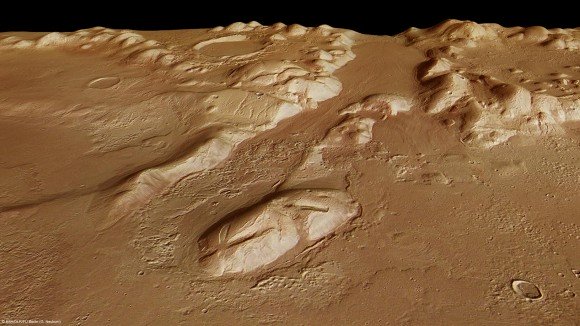When it comes to exploring Mars, one of the greatest needs future astronauts will face is water. Why? Simple enough. Transporting water would take a huge amount of fuel. Now the Mars Express has imaged an area on the red planet which may yield large quantities of sub-surface ice. It’s name is Phlegra Montes…
 The Astronomical Research Center (A.R.C) mentioned that Extending from the northeastern portion of the Elysium volcanic province to the northern lowlands, spanning latitudes from roughly 30°N to 50°N, the Phlegra Montes are a gently rolling series of hills that have been probed by radar. It is surmised these low mountain ranges are not volcanic in origin, but created through tectonic forces and may conceal a copious supply of frozen water.
The Astronomical Research Center (A.R.C) mentioned that Extending from the northeastern portion of the Elysium volcanic province to the northern lowlands, spanning latitudes from roughly 30°N to 50°N, the Phlegra Montes are a gently rolling series of hills that have been probed by radar. It is surmised these low mountain ranges are not volcanic in origin, but created through tectonic forces and may conceal a copious supply of frozen water.
Thanks to high resolution stereo imaging from ESA’s Mars Express orbiter, we’re able to detect a feature called ‘lobate debris aprons’. They appear to surround almost every mountain in the Phelegra’s and it’s a normal feature for mountains found around these latitudes. Earlier studies of the debris aprons show the material has slid down the mountain slopes with time – a feature shared with Earth’s glaciers. Because of this similarity, scientists surmise this region may be a type of Martian glacier. It’s a guess that’s also been confirmed by radar on NASA’s Mars Reconnaissance Orbiter.
According to the radar data, the lobate debris aprons could indeed signal the presence of ice – perhaps only 20 meter below the surface. To further confirm their findings, nearby impact craters also show signs of recent glaciation. It would appear that ridges formed inside these ancient holes from snowfall, and then slid down the slopes. With time, it compacted to form a glacier structure… and even more glacier flow patterns are visible in the valleys.
How did this come to be? A one time, Mars’ polar axis was quite different than it is today. As it changed, it created different climatic conditions and mid-latitude glaciers may have developed at different times over the last several hundred million years. While you might be tired of hearing about water on Mars, the findings are very exciting for the future of exploration. It means the door is open…